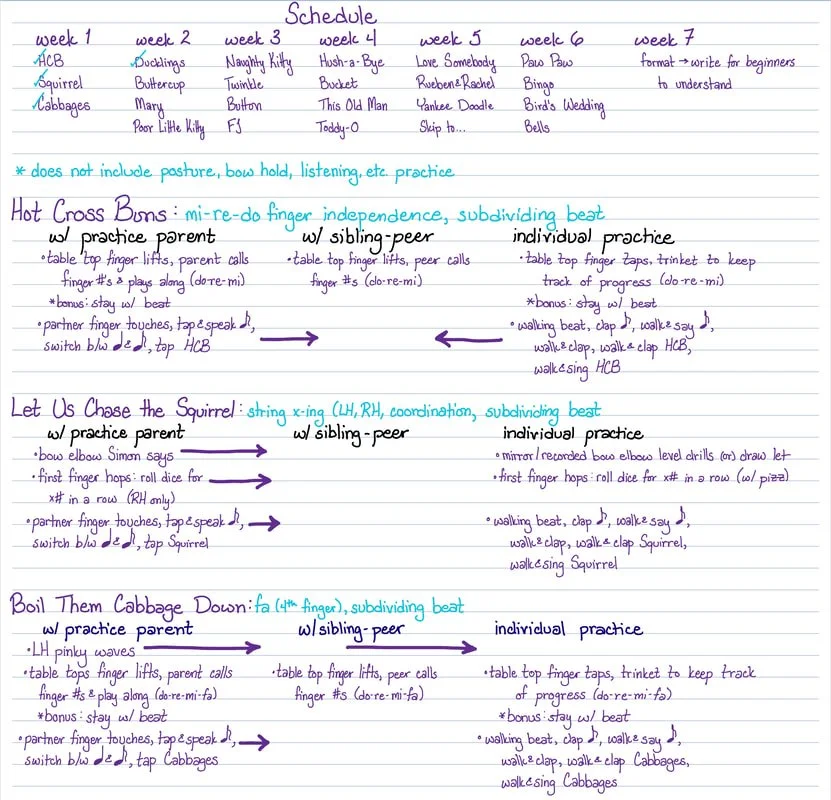WEEK 2: HOT CROSS BUNS, LET US CHASE THE SQUIRREL, AND BOIL THEM CABBAGE DOWN
Later this week I’ll be attending a coffee roundtable discussion with some of my fellow Kaleidoscopes for violin method teachers where we will discuss setting up a beginner bow hold. This seminar cannot come at a better time since I am just beginning on my practice charts for the first few songs in Kaleidoscopes Book 1. The roundtable conversation will be focused on how to teach when the ideal practice parent is available. Regardless, having other teachers to help me break down the steps of forming a strong and dynamic bow hold will allow me to better plan ways students can learn these skills with siblings/peers or individually.
For new readers, I am currently working on creating a supplemental practice guide to Kaleidoscopes Book 1 which details how to practice for the main teaching points of each song in three scenarios. The method is built around the idea that a parent or guardian will be able to consistently encourage, monitor, and direct a student’s practice. Although this parent and child connection does yield amazing results, it is not possible for many American families who have financial and time constraints. I believe that there are ways in which students can access a similar level of success to the students with ideal practice parents through practice that is divided between parent paired work, games with siblings or peers, and individual activities.
Building the practice guide
This week, I began working out the practice points for the first three songs in the Book: Hot Cross Buns, Let Us Chase the Squirrel, and Boil Them Cabbage Down. The great thing about beginner level violin books is that many of the songs work the same skills. This allows students to feel successful about “graduating” while continuing to work on a skill.
The primary skills for the beginning of the book are developing an awareness of and ability to control muscles which are not typically used. For example, students must learn how to move their ring finger independently of their middle finger or pinky finger. THIS IS SO HARD! To practice this skill, I lead students in tapping their fingers to their thumb. We do this at a slow, consistent tempo. Once they can easily tap their thumb, I have students place their hand on a table top and curve their fingers so that the tips and base of the palm are touching the surface. Then we practice lifting finger 1, finger 2, finger 3, finger 4. Somewhere in the process, I switch from calling numbers to calling solfege syllables, do, re, mi, fa. This encourages students to build a connection of both number and pitch to an individual finger. Eventually we will mix up the order and gradually increase the tempo. When my students become discouraged with how difficult this task is (and they almost always do), I recruit the parent attending the lesson to play the game with us. Watching their parent struggle always makes the student feel better about their own abilities.
At this stage, I typically am still introducing the bow hold. Starting around the fourth song in the book, All My Little Ducklings, students have typically developed enough facility with their left hand to spare some focus without things falling apart. Once the left hand facility is established, I have students return to the first songs and we renew them with the bow instead of the pizzicato that was used the first time through. The major challenge in teaching the bow is separating elbow movement from shoulder movement. The ability to open and close the “elbow gate” as I call it is new to almost every student. I address their motion long before the bow ever touches the strings, knowing that the shoulder motion will probably return once there is the distraction of the bow and violin added to the mix.
Challenges: This is hard, but I can do hard things?
A major challenge I faced this week was trying to decide what exercises a student will be capable of individually. The short answer is, it depends. Age, maturity, and motivation are all major factors in what skills a student will be able to learn without outside help. How can I teach a five year old to think critically about their right hand pinky? How do I motivate a fifteen year old to practice making fifty bow holds in a week? And how do I ensure the quality of the individual practice? I decided that this project will be geared towards students around ages eight to ten. These students tend to have some fine motor skills and are beginning to be able to think critically without intervention, but still need new ideas modeled to them extensively before they can recreate the idea themselves. I will have to go back after the completion of this practice list and create another geared towards students ages four to seven, and yet another geared towards students eleven to fifteen.
Another challenge from this week was deciding where to start. I decided not to include a list of practice techniques that the student must have practiced before playing Hot Cross Buns. The final version of the practice guide will include an introduction explaining that before beginning with songs, the student must have learned posture, violin placement, left and right hand differentiation, and introductory solfege. The primary teaching of the bow hold is also not included in the practice list. I have decided that only the refinement of the bow hold that is taught through the songs should be included. Supplemental work through practicing rhythms and other exercises will absolutely be necessary.
Hopefully next week I will have more clarity on what belongs on the practice guide.

